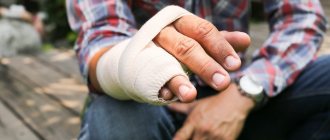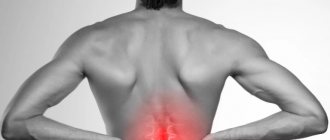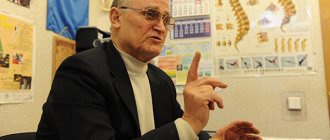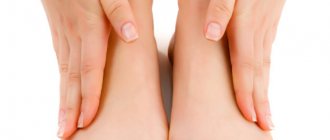A psychophysiological disease is any disease in which the physical symptoms are believed to be a direct result of psychological or emotional factors. This diagnosis means that psychological factors either initiated or are contributing to the back pain, or both.
It should be emphasized that although psychological factors may be the cause of physical symptoms, the symptoms are not substantiated by imaging techniques. However, actual physical problems (such as back pain) can be triggered by emotional factors.
The history of “stress back pain”
Dr. John Sarno, MD, a professor in the Department of Physical Medicine and Rehabilitation at New York University, recently popularized the idea of "stress-induced back pain," which he calls "Tension Muscle Syndrome" (TSMS), although the concept dates back to 1820. year.
Dr. Edward Shorter's book From Paralysis to Fatigue details the history of psychosomatic illnesses. And back in the 1820s, the diagnosis of “irritable spine” was made and this is essentially equivalent to the modern idea of stress back pain. The diagnosis of “irritable spine” was quite popular and spread throughout the world at that time.
Interestingly, Dr. Shorter opined that many doctors and patients of this era began to firmly believe in this diagnosis, even though there was no obvious pathology. Dr. Shorter noted that doctors put this diagnosis in the patient's head, increasing fears that a serious illness existed and recommending bed rest to patients.
The diagnosis of "irritation of the spine" remained quite common until the early 1900s. Dr. Shorter believes the diagnosis served "the need to remain competitive with other medical clinics in" medicalizing "patients with certain subjective complaints. It also served the needs of patients by providing an opportunity to "save face" and have a medical diagnosis, rather than addressing possible psychological and emotional factors, since most patients were reluctant to admit to having psychological problems.
The history of the diagnosis of "spine irritation" is useful for understanding current medical approaches to back pain. Even today, some doctors pay attention primarily to structural “explanations” for back pain, and convince their patient that “diagnostic findings” are the cause of the pain, thereby instilling fear in the patient, and then advise “justified” treatment. However, if the true cause of back pain is stress, then active treatment using physical methods may not be effective and cause even more stress in the patient.
And if we return to Dr. John Sarno's conceptualization of “stress-related pain,” we can see similarities with the concept of “spine irritation.” The most important difference is that Dr. Sarno places the primary causative factors (psychological and emotional) at the forefront of his treatment plan; while, some doctors continue to use only “physical” methods of treatment.
Specifically, Dr. Sarno's theory holds that most cases of back pain that are treated by the medical community using "organic" approaches are actually stress-related. It is important to note that this theory and treatment approaches are controversially accepted in the medical and psychological community, and do not yet have clear evidence obtained through scientific research.
Spinal and bone marrow
Spinal cord herniation. Debt of karma. In a past life, he left someone to die with a broken spine.
Bone marrow. Like a woman, being a spring of love, he is under the strong protection of a man - a bone - and does what a woman was created for - to love a man.
Meningitis of the spinal cord. Inflamed thinking and anger at life. Very strong disagreements in the family. Lots of clutter inside. Lack of support. Living in an atmosphere of anger and fear.
Osteomyelitis is inflammation of the bone marrow. Feelings that are not supported by others. Frustration, resentment and anger about the very structure of life.
How does stress cause back pain?
There are many theories about the causes of stress-related back pain. It is important to note that the overriding principle of all of these theories is that psychological and emotional factors cause certain physical changes that result in back pain.
In most theories of stress back pain, the cyclic pain gets worse as it continues, leading the patient to become restless and have trouble performing daily activities.
Cyclic pain is characterized by:
- The patient becomes unnecessarily limited in performing many functions of daily living
- This decrease in activity is due to the patient's fear of pain or injury.
- This fear may be exacerbated by the doctor's (close) recommendations to take it easy due to the presence of diagnosed small structural changes (which in fact may have nothing to do with back pain)
- Restrictions in movement and activity lead to impaired physical condition and weakening of muscles, which in turn leads to increased back pain
Of course, this cycle leads to increased pain, increased fear, and even greater physical maladjustment, along with other reactions such as social withdrawal, depression and anxiety.
The development of spinal diseases from a psychosomatic point of view
The psychosomatic interpretation of the causes differs depending on the part of the spine in which the pain occurred:
- The thoracic spine is responsible for emotions;
- lumbar region - a reflection of self-awareness;
- sacral region – unsatisfied need for love, feeling of loneliness, fear of financial problems.
This is interesting! If a person is confident in his abilities, is not afraid of obstacles, and goes towards his goal with concentration, then he is unlikely to have back problems.
Psychosomatics of the spine according to Louise Hay
Louise Hay sees the reason in the lack of flexible support in life. Psychosomatics by department:
- lower part – lack of financial support;
- middle part – guilt, fixation on the past;
- the upper part is the need for love, suppression of one’s feelings.
By Liz Burbo
Liz Burbo gives this explanation for spinal problems:
- Sacrum – fear of losing independence, refusal to help other people.
- Why does the lower back hurt: fear of material disadvantage. A person needs material wealth to feel more confident. Only a person cannot admit this either to himself or to other people.
- Thoracic spine – uncertainty, emotional instability.
- Neck – high expectations for other people, which makes it seem like a person carries everything on his shoulders.
Opinion of V. Sinelnikov
According to V. Sinelnikov, back problems reflect a lack of support and support in life. Life is perceived as a series of trials and an unbearable burden. Such people take on other people's problems without dealing with their own difficulties.
Dr. Sarno's theory
In Dr. Sarno's formulation of SNM, back pain is not related to mechanical or physical factors, but is caused by the patient's feelings, personality and subconscious problems. Key emotions include unconscious anger and rage. Additionally, he describes people who may develop strained muscle syndrome as a personality type with characteristics such as:
- Has strong internal motivation to achieve success
- Has a great sense of responsibility
- Purposeful and disciplined
- Self-critical
- Perfectionist and compulsive
Dr. Sarno's theory suggests that these personality characteristics interact with stressful life situations to lead to back pain. It is also noted that the source of psychological and emotional stress is not always obvious.
Dr. Sarno's theory of TMS describes the mechanism by which emotional stress is pushed from awareness by the mind into the unconscious. This unconscious tension causes changes in the nervous system. These changes cause blood vessels to narrow and reduce blood flow to various soft tissues, including the muscles, tendons, ligaments, and nerves of the spine. This leads to a decrease in oxygen supply, as well as the accumulation of biochemical waste in the muscles. This in turn leads to muscle tension, spasms and back pain experienced by the patient.
Spine
Disc, offset. Feeling like life is not supporting you at all. Indecisiveness.
Disorders in the spine by vertebrae. Cervical region.
S-1 - embarrassment, confusion, escape from life; feeling of not being good enough, endless internal chatter; attitude: “what will the neighbors say?”
S-2 - denial of wisdom, refusal to know or understand; indecision, indignation, indignation, feelings of resentment and guilt; there is no balance with life, denial of one’s own spirituality.
C-3 - accepting responsibility for guilt for others; guilt, torment, indecision, tormenting yourself; biting off more than you can chew.
C-4 - suppressed anger, bitterness; hidden feelings, unshed tears.
S-5 - ridicule, fear and humiliation; fear of expressing oneself; denial of goodness, a huge burden.
S-6 - attempt to fix others, lack of flexibility; resistance, great burden, overload.
S-7 - confusion, feeling of helplessness; lack of ability to achieve something.
Thoracic region
T-1 - too much to deal with; inability to manage it all; closing yourself off from life.
T-2 - reluctance to feel, heart shutdown; pain, wound.
T-3 - internal chaos, old deep wounds, inability to communicate.
T-4 - the need to attribute mistakes to others; sentence, condemnation.
T-5 - a dam for emotions, rage; refusal to let emotions flow.
T-6 - clogged, accumulated negative emotions; fear of the future; constant anxiety, lack of self-love; anger at life.
T-7 - Refusal to enjoy life, pain that persists.
T-8 - obsession with failure, resistance to one's own good.
T-9 - blaming others, feeling like a victim; feeling that life is letting you down, letting you down.
T-10 - refusal to take responsibility (take the initiative into your own hands); the need to be a victim: “it’s all your fault.”
T-11 - low opinion of oneself; fear of establishing relationships.
T-12 - denial of the right to life; feelings of danger, insecurity and fear of love; Inability to digest anything.
Lumbar region.
L-1 - crying for love and the need to be lonely/lonely; lack of feeling of security.
L-2 - you cannot forget the pain experienced in childhood; you don't see a way out.
L-3 - sexual assault, ill-treatment based on sex; guilt, self-hatred.
L-4 - denial of sexuality, refusal of sex; lack of financial stability; fear for career; feeling of powerlessness.
L-5 - lack of a sense of security, difficulty communicating; inability to accept pleasure; anger, anger.
Sacrum. Old, stubborn anger; lack of strength, power.
Coccyx. Lack of balance with oneself; persistence in something; blaming yourself; resentment towards others, sit on old pain.
The spine is a flexible support for life. The spine connects the energetic past, present and future. It, like a mirror, reflects the basic truths about a person. He characterizes the father. A weak spine means a weak father.
Curved spine - inability to follow the support received from life, from the father, attempts to adhere to old principles and outdated ideas, lack of integrity, completeness, distrust of life, lack of courage to admit that one is wrong, a father with twisted principles. If a child is hunched over, then his father probably has a gentle character.
At the height of each vertebra, channels extend into organs and tissues; when these channels are blocked by the energy of one or another stress, damage to an organ or part of the body occurs:
- From the crown to the 3rd pectoral + shoulder and upper arm + 1-3 fingers - feeling of love - fear that they don’t love me, that they don’t love my parents, family, children, life partner, etc.
- 4-5 pectoral points + lower part of the arm + 4-5th fingers + armpit - feelings of guilt and accusation associated with love - fear that they accuse me, they don’t love me. The accusation is that I am not loved.
- 6-12 thoracic vertebrae - feelings of guilt and blaming others - fear that I am being blamed, blaming others.
- 1-5 lumbar vertebrae - feelings of guilt associated with material problems and blaming others - fear that I am accused of being unable to solve financial problems, of wasting money, blaming others for all material problems.
- From the sacrum to the fingers - economic problems and fear of them.
Diagnosis of “stress pain” in the back
The diagnosis of stress back pain is often made based on a thorough medical history and physical examination. But patients should be careful when attempting to self-diagnose stress back pain, as the pain may be due to a serious medical condition (such as a spinal tumor or infection). A thorough physical examination using imaging techniques can usually rule out more serious structural causes of back pain in most patients.
In cases where back pain is related to stress, the history of back pain is often quite variable. The pain may occur after a specific incident or appear suddenly. For example, pain often begins with an incident of muscle and ligament sprain, but does not disappear due to the influence of emotional factors, although the muscles and ligaments have already recovered from the injury.
In many cases, an MRI scan may reveal disc protrusion or osteochondrosis, although stress is actually the cause of back pain. In these cases, the MRI findings are not clinically significant and ultimately these changes are not considered the cause of the pain.
Common characteristics of stress back pain include symptoms such as:
- Back pain and/or neck pain
- Diffuse muscle pain
- Painful spots in the muscles
- Sleep disturbance and fatigue
- In many cases, with stress back pain, patients complain of migration of pain
In general, the symptoms of stress back pain are similar to those seen with fibromyalgia.
According to Dr. Sarno, the diagnosis of SUI is made only when organic causes of pain have been completely excluded, and at the same time, the characteristic features of SUI are present.
Muscles
Muscular dystrophy. An insane desire to control everything and everyone. Loss of faith and trust. A deep need to feel safe. Extreme fear.
Progressive muscular dystrophy. Reluctance to accept one's own worth and dignity. Denial of success.
Muscles. Represent our ability to move through life. Resistance to new experiences.
Muscle atrophy is muscle shrinkage. Arrogance towards others. A person considers himself better than others and is ready to defend this at any cost. He doesn’t care about people, but he craves fame and power. Illness comes to help prevent mental arrogance from turning into outer violence.
Overexertion of the lower leg muscles indicates a conscious desire to rush; shrinkage means suppression of sadness. For example, all the men in the family were forced to tiptoe for fear of interfering with their mother in her eternal hurry. Men in the family were given a secondary role in household affairs. Walking on tiptoes means extreme obedience.
Muscles. Attitude towards mother and woman.
Muscle death. Excessive sadness because of one's poor athletic form or simply one's lack of physical strength.
- in men - sadness due to their male helplessness
- for women - exhaustion of oneself like a man, an attempt to overcome sadness by force.
So what should we do with all this now? How to treat?
Lower back pain should not be left untreated . Psychosomatics explains the reasons, but they are eliminated in a complex manner. Balance your physical and emotional spheres.
Consult a therapist, he will prescribe medications to relieve symptoms. These can be injections, tablets, ointments.
Don't forget about physical education. Gymnastics will help strengthen and stretch the back muscles and relieve stress from the spine. Don't overdo it with running or heavy weights. For starters, a regular set of physical therapy will do.
Work with a therapist about old traumas and expressing emotions. Perhaps he will prescribe antidepressants. Try to get rid of fears and realize that the future is in your hands.
Yoga practice and auto-training help a lot . Mantra from Louise Hay: “In my life I personify both strength and power. I consign the past to oblivion and rely on my own strength.”
If you cannot identify the problem and get rid of it yourself, you should visit a psychologist.
What is the “Chicago Seven” and how relevant is such a classification today?
I don’t really need classifications of psychosomatic disorders in my daily work, and I first learned about the “Chicago Seven” thanks to this question. I read it and was horrified. Can anyone really seriously consider them in the 21st century as “diseases of unreacted emotions”! I will list these seven diseases indicating their true causes:
- Arterial hypertension is a disease based on a genetic predisposition, which is caused by dozens of additional factors (smoking, excess weight, salt abuse, physical inactivity, increased sugar and cholesterol levels, and so on). Stress is only one of the risk factors, but far from the main one.
- Peptic ulcer of the stomach and duodenum is a disease whose cause was well studied at the end of the 20th century. This is a microorganism called Helicobacter Pylori. Yes, acute “stress” ulcers have been described, but that’s a completely different story.
- Inflammatory bowel diseases (ulcerative colitis and Crohn's disease) are a group of inflammatory autoimmune diseases with a genetic predisposition.
- Neurodermatitis (atopic dermatitis) is a disease that has a genetic predisposition. A stress factor can only in some cases cause an exacerbation.
- Bronchial asthma is a chronic inflammatory disease with a clear genetic predisposition. Sometimes stress can contribute to an exacerbation, and sometimes vice versa - stimulation of the sympathetic nervous system leads to dilation of the bronchi.
- Thyrotoxicosis (hyperfunction of the thyroid gland) is a classic autoimmune disease, which is based on the production of antibodies to the tissues of the thyroid gland. Here, would-be psychologists generally confuse cause and effect. Thyrotoxicosis greatly changes a person's character - he becomes whiny, hot-tempered, and nervous. After thyrotoxicosis is cured, mental manifestations completely disappear.
- Rheumatoid arthritis is a disease of unknown nature (the connection between genetic and infectious factors is being discussed). However, stress definitely has nothing to do with it.
Test by doctors Holmes and Rage for psychosomatic susceptibility
Predisposition to psychosomatics is directly related to stress resistance: the higher the stress resistance, the less susceptibility. In 1967, Doctors Holmes and Rage developed a test to determine stress tolerance.
How to pass the test: select from the table those situations that have happened to you over the past year. If some event was repeated several times, then count it as many times as it happened. As a result, you need to calculate the sum of all situations (scores for each episode are shown in the table below).
| № | Situation | Point |
| 1 | Death of husband (wife) | 100 |
| 2 | Divorce | 73 |
| 3 | Discord in relationships, breakup, separation | 65 |
| 4 | Prison term | 63 |
| 5 | Death of someone in the family | 63 |
| 6 | Illness, injury | 53 |
| 7 | Marriage | 50 |
| 8 | Dismissal | 47 |
| 9 | Reconciliation with a partner (husband, wife) | 45 |
| 10 | Retirement | 45 |
| 11 | Illness in a family member | 44 |
| 12 | Pregnancy (if you are a man, then your partner is pregnant) | 40 |
| 13 | Sexual problems | 39 |
| 14 | New addition to the family | 39 |
| 15 | Change of place of work | 39 |
| 16 | Financial changes | 38 |
| 17 | Death of a friend | 37 |
| 18 | Change of work activity | 36 |
| 19 | Increased frequency of conflicts and quarrels in relationships with husband (partner) | 35 |
| 20 | Large loan, loan | 31 |
| 21 | Debts, financial difficulties | 30 |
| 22 | Moving up the career ladder, increasing job responsibilities | 29 |
| 23 | Child leaving home | 29 |
| 24 | Problems in relationships with in-laws | 29 |
| 25 | Success, achievement | 2 |
| 26 | Dismissal or return to work of a spouse | 26 |
| 27 | Enrollment or graduation from a university (other educational institution) | 26 |
| 28 | Any changes in living conditions | 25 |
| 29 | Changes in habits, behavior | 24 |
| 30 | Conflicts at work | 23 |
| 31 | Change of working regime | 20 |
| 32 | Moving | 20 |
| 33 | Change of place of study | 20 |
| 34 | Vacation or changes in holiday habits | 19 |
| 35 | Changes in religion | 19 |
| 36 | Changes in social activity | 18 |
| 37 | Small loan or loan | 17 |
| 38 | Changes in sleep patterns, including sleep disturbances | 16 |
| 39 | Changes in the frequency and nature of meetings with relatives | 15 |
| 40 | Any changes in diet | 15 |
| 41 | Vacation | 13 |
| 42 | Christmas, New Year, Birthday | 12 each |
| 43 | Fines or hidden violation of law and order | 11 |
| AMOUNT OF POINTS: |
Interpretation of the result:
- 200–274 points – normal level of stress, good level of stress resistance;
- 275–299 – dangerous level of stress, low resistance to stress;
- more than 300 points - any problem makes you angry; we can safely say that all your illnesses have psychosomatic causes.
It is important! If according to the test results you received a second or third result, then you need to urgently contact a psychotherapist!








